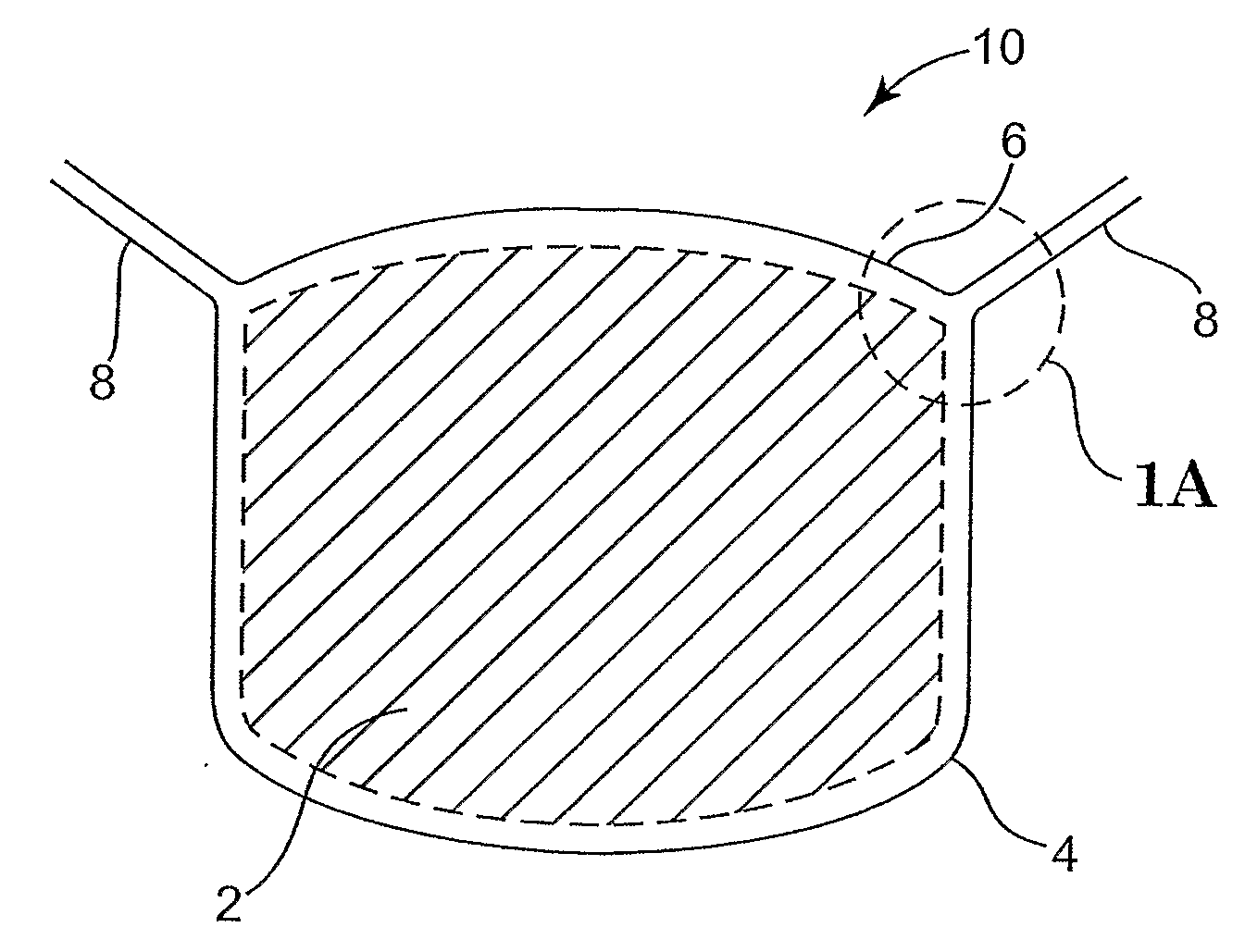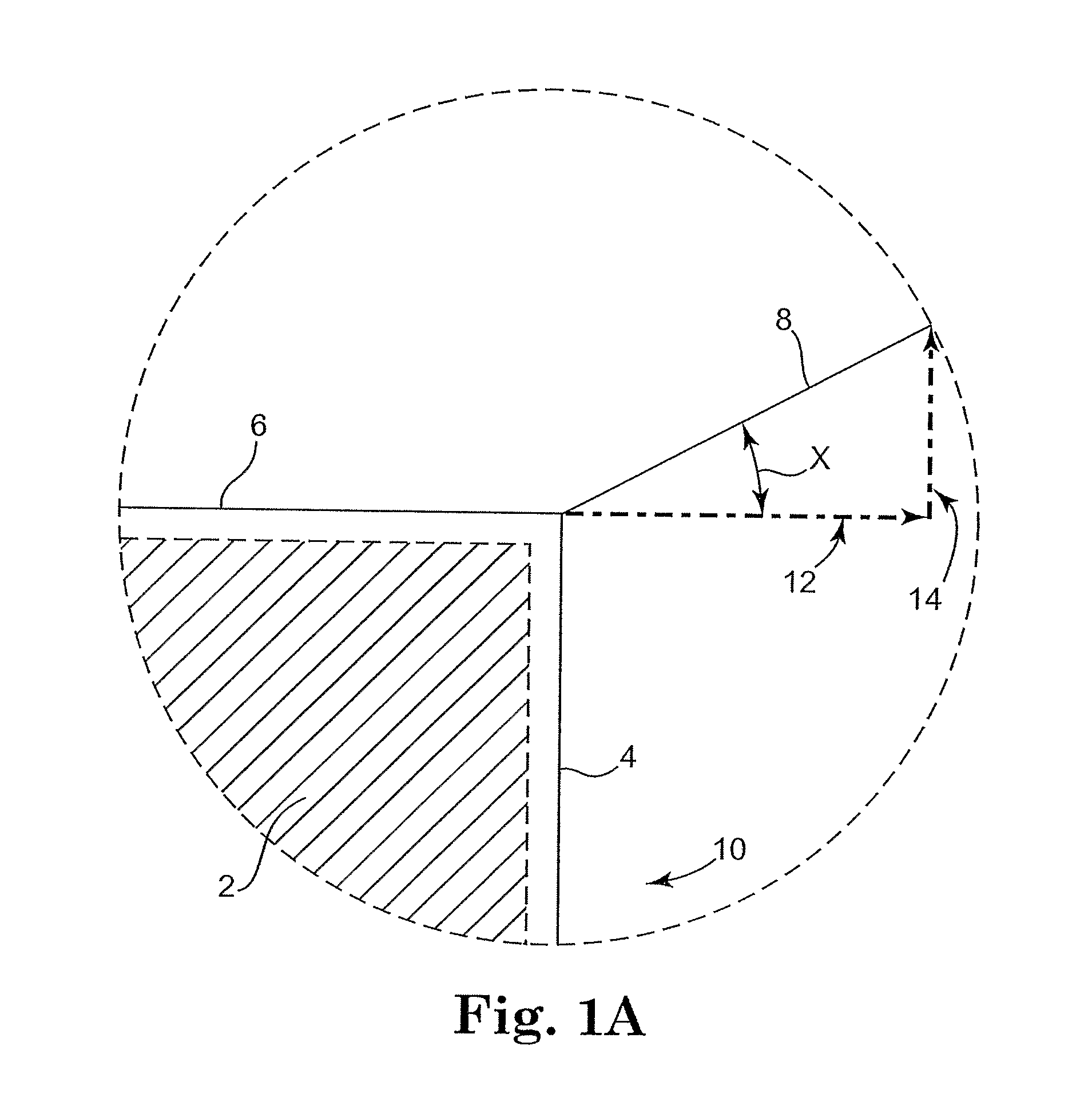[0008]Broadly, exemplary dough compositions can be formulated to exhibit a conventional raw
specific volume during preparation and
processing. The dough can be packaged and can expand (e.g., leaven) during refrigerated storage based on the action of chemical leavening agents to become proofed or partially proofed during refrigerated storage within the
package. The
package can be sized, and the dough composition can be placed in the
package, to accommodate expansion of the dough composition within the package to within a desired range of
specific volume, while achieving a desired internal package pressure. The desired
specific volume can be a specific volume that will increase total expansion of the dough composition during baking, meaning that the desired raw specific volume within the package results in an increased cooked (e.g., baked) specific volume, relative to a lower raw specific volume. The
internal pressure upon expansion of the dough composition within the package can be sufficient to result in refrigerated storage stability, can optionally provide protection to the leavened or partially leavened dough composition contained in the package, and can for example be greater than
atmospheric pressure but not as high as other standard pressurized refrigerated dough packages, e.g., not as high as about 15
pounds per square inch, gauge.
[0012]According to certain embodiments, a soluble acidic
leavening agent can contribute to a desired raw specific volume. In general, a soluble acidic agent (as opposed insoluble acidic agent) can react to produce leavening gas during refrigerated storage. This gas can increase the specific volume of the raw dough by causing the dough to expand during refrigerated storage, while contained in a dough package. Secondarily, the gas produced during refrigerated storage can contribute to increased baked specific volume of the dough composition by expanding during baking. Thus, the increased raw specific volume results in an increased baked specific volume.
[0013]In addition to soluble acidic chemical
leavening agent, embodiments of the invention can also include insoluble acidic chemical
leavening agent. The insoluble acidic chemical leavening agent does not substantially dissolve at
processing or refrigerated storage temperatures, but will dissolve at elevated temperatures such as cooking (e.g., baking) temperatures. Upon dissolving at an elevated temperature, the insoluble acidic chemical leavening agent will contribute additional leavening gas to further expand the dough during cooking and increase specific volume.
[0017]Certain embodiments of dough compositions can be placed in a flexible package while frozen, and optionally with vacuum to remove gases from the package, then sealed. For example, a frozen dough can be placed in a flexible package that has sufficient internal fully-sized volume to allow for expansion of the dough composition within the package during refrigerated storage. The dough (if frozen) can thaw in the package and during refrigerated storage the dough can expand to a degree that fills the fully-sized volume, or a substantial portion of the fully-sized volume of the package without producing excessive pressure inside the package. For example, the dough can expand during refrigerated storage from a raw specific volume in the range from 0.9 to 1.1 cubic centimeters per
gram to a raw specific volume in the range from about 1.7 to 2.3 cubic centimeters per
gram, to produce a packaged dough product having an
internal pressure in the range from 8 to 10 psig. The dough composition can be stored in this package at refrigerated conditions for a useful amount of time, e.g., for up to 6, 10, 12, or more weeks without spoiling and without an excessive increase in the size or
internal pressure of the package, which means no ballooning due to excessive production of
carbon dioxide by the dough within the package that increases the package headspace.
[0018]Advantages of embodiments of the invention can include a relatively higher baked specific volume due to a relatively higher raw specific volume achieved by a dough composition during refrigerated storage. Further, according to some embodiments of the invention, a desirably low headspace and moderate internal package pressure can provide protection for a packaged dough product from physical damage that may otherwise occur during transport, storage, handling, and other movement and manipulation of the product. Thus, a combination of improved baked specific volume and added protection of a dough product within the package can be achieved by providing a dough composition that includes a relatively higher raw specific volume when packaged, and providing a moderately-pressurized package that surrounds the dough composition during transport, storage, handling, etc. Exemplary raw specific volumes may be in the range from about 1.7 to about 2.3 cubic centimeters per
gram. Exemplary internal pressure of a packaged dough having a raw specific volume within the range from about 1.7 to about 2.3 cubic centimeters per gram may be in the range from about 8 to about 10 psig. Headspace within the pressurized dough package may be relatively low, e.g., less than 10 percent, less than 5 percent, or less than 2 percent.
 Login to View More
Login to View More  Login to View More
Login to View More 


